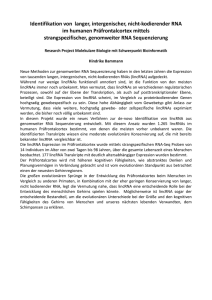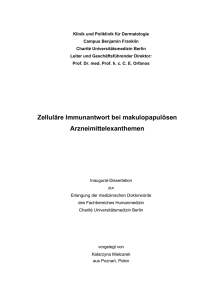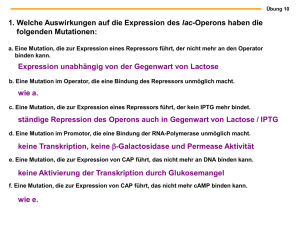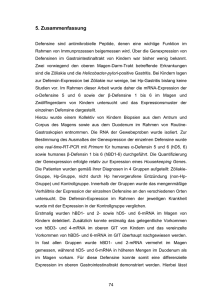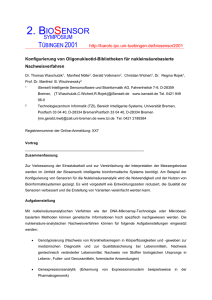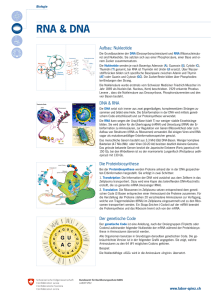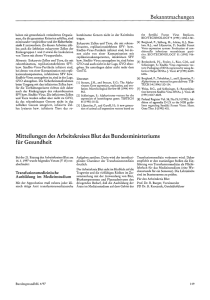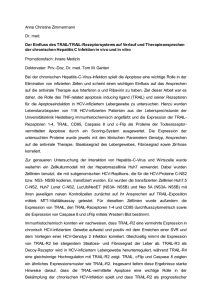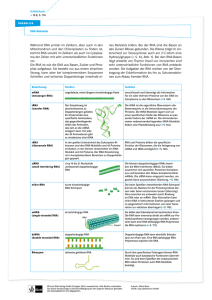Abstract - ETH E
Werbung
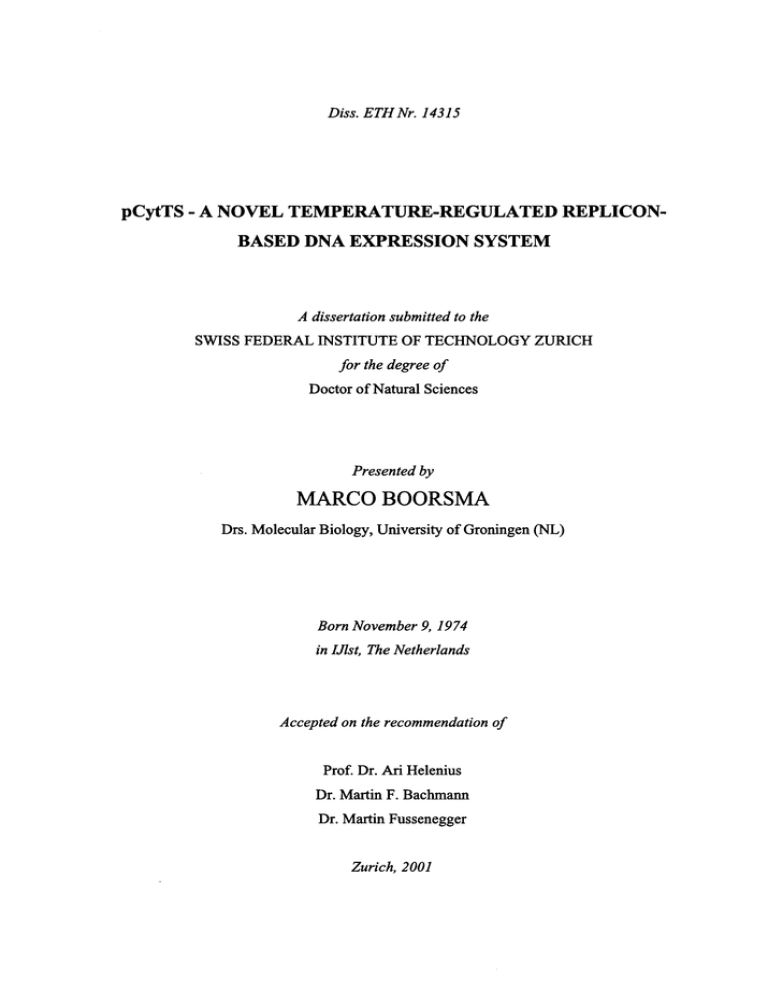
Diss. ETH Nr. 14315 pCytTS - A NOVEL TEMPERATURE-REGULATED REPLICONBASED DNA EXPRESSION SYSTEM A dissertation submitted to the SWISS FEDERAL INSTITUTE OF TECHNOLOGY ZURICH for the degree of Doctor ofNatural Seiences Presented by MARCO BOORSMA Drs. Molecular Biology, University of Groningen (NL) Born November 9, 1974 in Lllst, The Netherlands Accepted on the recommendation of Prof. Dr. Ari Helenius Dr. Martin F. Bachmann Dr. Martin Fussenegger Zurich, 2001 CHAPTER I Summary With the rapid discovery of new potential drugs and drug-targets, many proteins need to be routinely produced in large quantities. A considerable part of these proteins has detrimental effects on host cell metabolism leading to poor cell growth and low production levels. By using inducible expression systems, a large biomass can be produced under non-permissive conditions resulting in high levels of recombinant protein upon induction. To be of broad benefit an inducible system should be specifically induced by the exogenous inducer, should be independent of endogenous cellular factors, and should leave unrelated cellular pathways unaffected. Furthermore, induction should be reversible and precise; the inducer should rapidly penetrate to the site of interest and be easily removed after induction. Alphaviruses are positive-stranded cytopathic RNA viruses with a small genome that is amplified in the cytoplasm by the alphaviral RNA-dependent RNA replicase. The high levels of alphaviral RNA and envelope proteins produced in infected cells suggested their use for powerful transient expression vectors. Several alphavirus-based expression technologies have been developed in which the genes encoding the envelope proteins were replaced by the gene ofinterest. To facilitate the study and handling ofthese RNAbased vectors, layered cDNA-based vectors were developed that contain the alphavirus sequences under control of a strong RNA polymerase 11 promotor. Upon DNA transfection of a host cell, RNA encoding the viral replicon is transcribed and transported to the cytoplasm where it replicates as during viral infection. By introduction of two mutations in the viral replicase, we constructed a temperatureinducible alphavirus replicon-based DNA expression system, designated pCytTS. The first mutation retained the replicase noncytopathic; the second mutation rendered the replicase temperature-sensitive, resulting in a temperature-regulated expression system. The system is characterised by undetectable basal level expression at 37°C and a linear increase in expression by lowering the temperature. Maximal protein production was at 29°C. Several proteins, including toxic proteins have been produced in different cell lines and in different reactor formats, including spinner flasks and hollow fiber reactors. The pCytTS system produced high quality proteins as determined by different functional assays. The study of the processes leading to inducible expression revealed an important role for RNA transcription and nuclear export. Increasing these processes resulted in increased cytoplasmic RNA levels and over 80-fold increased protein production without influencing basal level expression. Furthermore, uncoupling of transcription and RNA transport in the non-induced state from the cytoplasmic replication events in the induced state facilitated the study and optimisation of the expression system. A mathematical model of the RNA production in inducible expression systems was designed and tested Chapter 1 using real-time PCR. The model predicted a strong effect of RNA degradation on pCytTS-mediated expression. The presented study resulted in the development of an inducible expression system that combined the high expression levels of alphavirus-based vectors with the simple mode of induction by temperature shift and that meets all criteria for the production of difficult-to-produce proteins. 10 CHAPTER2 Zusammenfassung Mit der raschen Entdeckung potentieller neuer Drogen und Drogen-Targets, müssen viele Proteine in großen Quantitäten routinemäßig produziert werden. Ein beträchtliches Teil dieser Proteine hat Schädliche Effekte auf dem Stoffwechsel des Gastgeberzelles, der zu schlechten Zellenwachstum und niedrige Produktions-levels. Indem man induzierbare expressionssysteme benutzt, kann eine große Biomasse unter nicht freizügigen Bedingungen produziert werden und hohe Stufen des recombinanten Proteins erhalten werden. Um von breiten Nutzen zu sein, sollte ein inducierbares System ausdrücklich von der exogene Inducer aktiviert werden, sollten von endogene zellulare Faktoren unabhängig sein und sollten nicht zusammenhängende zelluläre Pathways unberührt lassen. Weiterhin sollte die Induktion reversibel sein und leicht zu entfernen sein nach der Induktion. Alphaviren sind positiv gestrandete cytophatische Viren mit einer kleinen Genome, die im Zytoplasma von der Alphavirus RNA abhängigen RNA replicase amplifiziert wird. Die hohe Konzentrationen von Alphavirus RNA und in infizierten Zellen hergestellten enevlope proteinen vorschlugen ihren gebrauch für leistungsfähige auf Alphavirus basierte transiente Expressionsvektoren. Mehrere Expressionstechnologien sind entwickelt worden in welcher die Gene, die für die Envelope Gene kodieren, ausetauscht sind für das Gen von Interesse. Um die Studie und die Bearbeitung dieser RNA basierten Vektoren zu erleichtern, wurden "layered" cDNA basierte Vektoren entwickelt die Alphavirus sequenzen enthielten unter kontrolle einer starke RNA Polymerase 11 Promotor. Auf DNS transfecktion einer Gastgeberzelle wird RNA transcribiert das für das virus Replicon kodiert und transportiert zum Zytoplasma wo es repliziert wird wie es passiert bei einer Virus Infektion. Durch einbauung von zwei zwei Mutationen in der Virus-replicase bauten wir ein Temperatur induzierbares Alphavirus replicon ein basiert auf einen DNS Expressionssystem. Es wurde pCytTS genannt. Die erste Mutation bewahrte die Replicase Noncythpatisch; die zweite Mutation machte die replicase temperaturempfindlich, was in ein enzymatisch regulierbares Expressionssystem resultierte. Das system ist Charakterisiert durch eine undetektierbare basale expression bei 37°C und eine lineare zunahme der Expression, indem man die Temperatur senkt. Maximale Proteinproduktion trat auf bei 29°C. Mehrere Proteine einschließlich giftigen Eiweißen sind in verschiedene Zelllinien und in verschiedene Reaktor aufbauten, einschließlich Spinner Flasks und hohle Faserreaktoren hergestellt worden. Das pCytTS System stellte eine hohe Qualität von eiweißen her, wie durch verschiedene Funktionelle Prüfungen bestätigt wurde. Chapter2 Die Studie über die zu induzierbare Expression führende Prozesse zeigte eine wichtige Rolle für RNA Transkription und Kemexport. Durch die Optimierung der Prozesse, die zu durch Induktion erhältlichen Expression führen, konnten die Expressions-Levels 80-fach erhöht werden ohne die basale Expression zu beeinflüssen. Ausserdem erleichterte das Lösen der Kopplung zwischen Transkription und RNA Ttransport in der nicht-Induzierte Zustand von den Cytoplasmatische Replizierungs "events" im Induzierten Zustand die Studie und die Optimierung des Expressionssystems. Ein mathematisches Modell der RNA-Produktion in induzierbare Expressionssysteme wurde entworfen und getestet durch Real-Time PCR. Das Modell sagte eine starke Einfluß von RNA Degradierung auf die pCytTS Expression vorher und unterstützte experimentelle Daten die die Wichtigkeit zeigten von erhöhte RNA Konzentration in der nicht-Induzierte Zustand von "High-level" Expression. Die geführte Studie führte zur Entwicklung eines induzierbares Exressionssystems, das die hohe Expressionslevels von Alphavirus stammende Vektoren mit dem einfachen Modus der Induktion durch eine Temperatursprung kombinierte und dazu alle Kriterien für die Produktion von schwer-zu-produzierende Proteine Entspricht. 12
